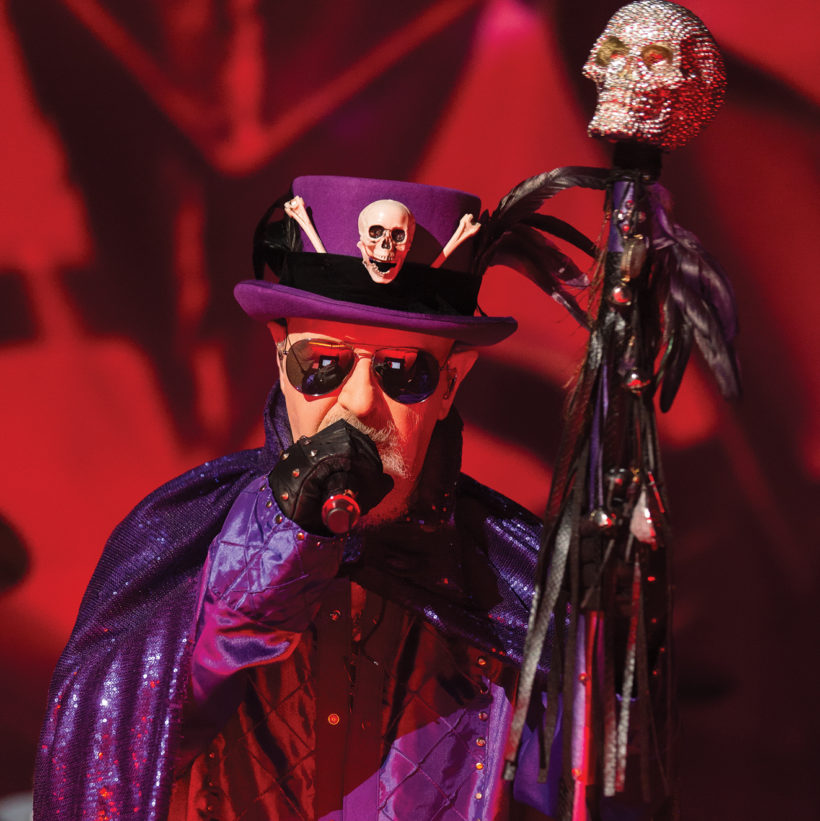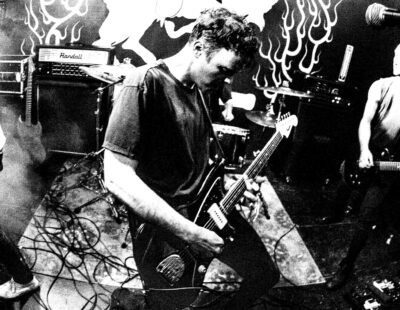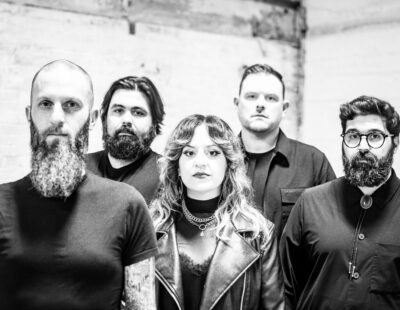
Legendary Judas Priest vocalist/Metal God, Rob Halford, has some unexpected free time on his hands these days. And it’s not due to the pandemic. The band was forced in late September to cut short the U.S. portion of its “50 Heavy Metal Years” tour when guitarist Richie Faulkner (who replaced K.K. Downing in the band in 2011) suffered an aortic aneurysm and complete aortic dissection while performing onstage in Kentucky on September 26. While Faulkner recuperates, Halford has been using his down time to promote the mind-blowing new Judas Priest box set, 50 Heavy Metal Years of Music, which was issued on October 15 and is available in limited quantities.
This 42-CD(!) box set, which Halford refers to as a “metal museum,” honors the long-lived Birmingham metal pioneers in glorious fashion. It includes every official live and studio album to date, plus 13 unreleased discs of live and rare material, all of it restored and mixed by longtime Priest producer, Tom Allom. Other non-musical additions include: Ross Halfin photos signed by each current band member (Halford, Faulkner, Glenn Tipton, Ian Hill and Scott Travis); a numbered British Steel metal razor blade (blunt); a memorabilia book featuring rare photos, posters, adverts and passes; a replica British Steel tour program; two replica tour posters from the 1980 British Steel German tour and the 1984 Defenders of the Faith European tour. It is a massive collection of music and memorabilia befitting one of the most influential bands in metaldom. For those who can’t shell out the nearly $500 for the full box set, a two-disc CD or vinyl version, Reflections: 50 Years of Heavy Metal Music, is also available. Orders for either the box set or Reflections can be placed here.

Though Halford would prefer to be onstage celebrating the band’s 50th anniversary with fans, he’s equally excited about the new box set and took some time for a Zoom chat with Decibel to discuss this exhaustive retrospective, and reflect on 50 years fronting Priest.
Calling Judas Priest: 50 Heavy Metal Years of Music a “box set” seems like it sells this amazing collection short. This is a treasure trove; it’s the only Judas Priest you’ll ever need to own.
Thank you! Who came up with box set? It’s so very clinical. I like your term “treasure trove.” I’ve been calling it the “metal museum,” because it’s definitely that. I remember when it was delivered to my house in England and I took it off the postman, and he was like, “my back’s killing me.” [Laughs] I took it in the kitchen, and I should have done a Youtube unwrapping video, ’cause I was like a kid. I hadn’t seen it in its final form. I sat there and looked at it and thought, at least this is something physical and tangible to take you through the decades. That seems to be hitting the heartstrings of a lot of the fans around the world, because you see them doing the unboxing and putting it on social media they’re just as excited as all of us are when they look at this great monument to metal.
Does the band have an archivist who’s gathered stuff over the years?
You know, I know that’s how a lot of bands are doing it these days, and I urge bands, even when you’re jamming, to stick a phone up in a corner and just press record and leave it. Because these are incredibly important parts of who you are. We came from a place where we had none of that—no camcorders, even. I have some 8mm [film] footage of one of the first trips Priest ever made to America. It shows us on the tour bus going down the Las Vegas strip. You can see signs for Frank Sinatra, Sammy Davis, Jr. and Englebert Humperdink. There’s also footage of our trip to Niagara Falls, where the whole of Niagara Falls is frozen, because it was one of the most freezing winters they’d had there for decades. So everything is important to keep.
Going back to the early ’80s, we had a friend of ours, a wonderful Scottish guy named Dungy, who stood seven foot something, and he would record every Priest show and then give me cassettes. I’ve actually got hundreds of these cassettes. We didn’t really need to delve into those, though. We found all of these other resources, and we had an abundance of stuff to look at. It was just a case trying to make sense of what to put where.
How hands-on were you and the other members in assembling some of the rare or previously unreleased material?
It was a team effort. It’s one of those things where too many metal cooks spoil the metal broth, because it’s like, I want that on! No, you can’t have that on! Why can’t I have that on there? Because we’ve got this on there! There’s all this great passion. So we had a wonderful team of people in London and New York, and they would just send us their ideas. We’d also have input as a band. I think we were all looking for the same outcome.
Yeah, everybody pitched in and we saw it slowly coming together. It took a hell of a long time, as something like this would and should. Needless to say, we’ve got a lot of things that are still in the vaults. So maybe there’ll be a box set at 60, who knows. Why not? [Laughs]
It’s pretty incredible that your label got behind such a huge piece such as this. That must be gratifying to get that kind of support.
Yeah, the bulk of our [recording career] has been with what was Columbia/CBS/Epic/Sony. We’re still under that big Sony family umbrella, and we’ve worked with some wonderful people over the decades. They’ve all had their hearts in the right place, working with Priest, because those early times were pretty rough. You’d try to connect, and then you’d go through a period where “metal is dead,” and it’s all punk and new wave and everything. The label stuck with us every step of the way. They’ve always been incredibly supportive, and every person we’ve worked with has been genuinely a fan of Priest. Some of the [label] heads still come to our shows when we’re in the New York area. They don’t have to, but they do, because they love the band and they want to see their band live.
You can’t beat seeing the band live; that’s when it all makes sense. When you see your band live, playing the music that you’ve got on your label, then it completes the journey. I’ve always said, when you write a song, it only completes its journey when you’re playing it live to your audience, to your fans. It’s the final piece of the puzzle, when you get the communication, the emotion and the reaction in real time. So, yes, the label has been incredibly supportive of this whole endeavor. They equally had their input and their metal fingers are all over the box set.
What were some “discoveries” that stood out to you in putting this together?
There’s an early performance of “Victim of Changes” from the Agora Ballroom in Cleveland, from 1978. That song—then and now—is probably one of the most important songs that Priest plays. We still play it live; we were playing it on the current tour. It’s just a real statement of all of the nuances of metal. The way it starts with the dual lead guitars and then the big sledgehammer riff and screaming vocals and the quiet bits in the middle and incredible lead break from Glenn and the end with the scream and all that—it’s got everything in it in that song. So we felt that was an important song [and performance] to include.
Also, the Mudd Club show [Live at the Mudd Club ’79], where I handcuffed Andy Warhol and he dragged me off to Studio 54 in New York City. All the songs carry something more than just the music. There’s something attached to them; there’s a story behind each one that I think is also valuable.
In the times I’ve interviewed you and other members of Priest for Hall of Fame stories, it’s come up frequently that Judas Priest was always pushing forward and unwilling to keep doing the same kind of album over and over. This box set really spotlights that. It’s 100% Priest, obviously, but the contrast between Rocka Rolla and Painkiller or Point of Entry and Firepower is pretty dramatic.
When you [open the box set] and put all the albums out in front of you, you look at each cover and you hear the songs in your head. And that’s another great sort of mind meld metal that’s created when you’re looking at something physically and not pulling it out of a cloud. You’re looking at the original artwork of, say, Painkiller and immediately your mind goes to the song “Painkiller,” “Night Crawler” and “All Guns Blazing.”
Going through all the different albums and eras like that, it re-emphasizes that no matter what we do, whether it’s “Turbo Lover” or “Eat Me Alive,” it’s still metal, from our world. And just by definition of the characters in the band and the writers, yes, we never wanted to miss any opportunity that we got. I don’t think we ever went, we can’t do that, it’s not metal enough. Because by the time it’s finished, it is metal enough.
This box set is also a great physical manifestation of the enormity of a 50-year career. What would 20-year-old Rob Halford have made of all this?
When you’re in a band, you have no clue [what lies ahead]. I’ve always said it’s such a fragile existence. A band can come off as tough and as heavy and strong and powerful as anything in the world, but internally it’s as fragile as glass. Bands break up for the smallest, simplest reasons. Sometimes it’s deeper, but that’s what you’re dealing with.
I remember an amazing interview I saw with the Beatles, when they had suddenly gotten successful, and somebody said to Ringo, “Do you think this is gonna last, Ringo?” And he goes, “If it ends, I’ll open a barber shop.” [Laughs] It’s a fine line between absolutely immersing yourself in a serious embodiment and pursuit in life, and at the same time carrying it lightly. It’s like sitting loose in the saddle of life. Rock ’n’ roll is so unpredictable, as it should be. Rock ’n’ roll is chaos. There shouldn’t really be any predictability, say, to say, “young, 20-year-old Rob, you’re going to have a 50th anniversary box set.” That’s what I love about what we do in music, in general, but particularly in heavy metal. Who knew? We were there at the start. We were there at the roots of heavy metal. And that’s the biggest thrill for me, to feel that I’m still in this great band that was there at the kick-off. That’s something that’s really hitting home now in my 70th trip around the sun.
To be still performing and recording 50 years later I’m sure would have been inconceivable to 20-year-old Rob.
Most people in England are retired at 50. You put your feet up; it’s the end. You start puttering around your garden and sitting in your deck chair with a cup of tea. It’s true that you thought back then that rock ’n’ roll was a young man’s adventure, that even 50 is a stretch.
There was a little kid at a recent show. He was on his dad’s shoulders, and he knew all the words to all these Priest songs. He was like eight years old. I brought him up on the stage and signed his shirt. And that’s when I go, “please, god, give me another 50 years, because I don’t want it to end.” I genuinely from the heart do not want it to end. So these are all just glorious moments to live to the full and celebrate every day, whether you’re on stage or not.
You’re fortunate, also, that at 70 you can still go out and perform at a very high level.
I am blessed. I’ve always said that once I start to sound like a British pub singer, just grab the mic from me [croons “Living after mid-niiiiight”]. I might end up on the Las Vegas strip in some dive bar. [Laughs] I love to get on stage. We all do, all of us in Priest. It’s a genuine desire to make that final part, complete the journey I spoke of before, when you’re playing live. That’s what it’s all about. That’s when it all makes sense.






